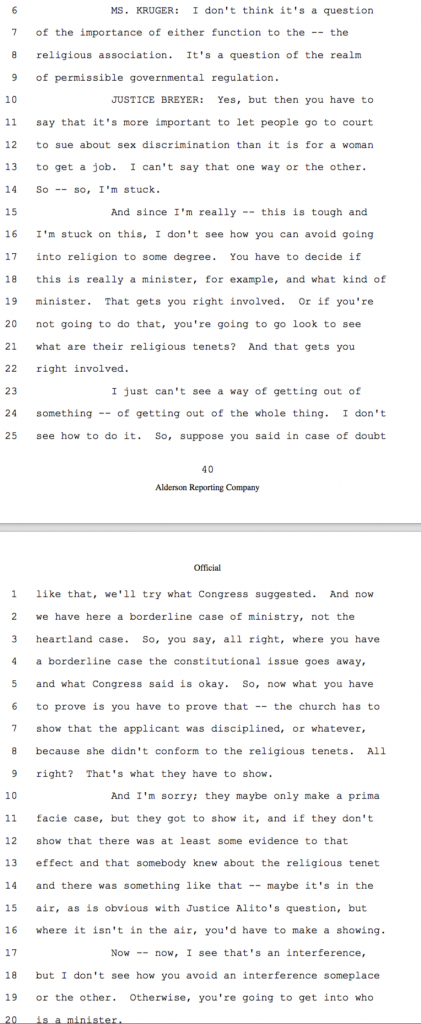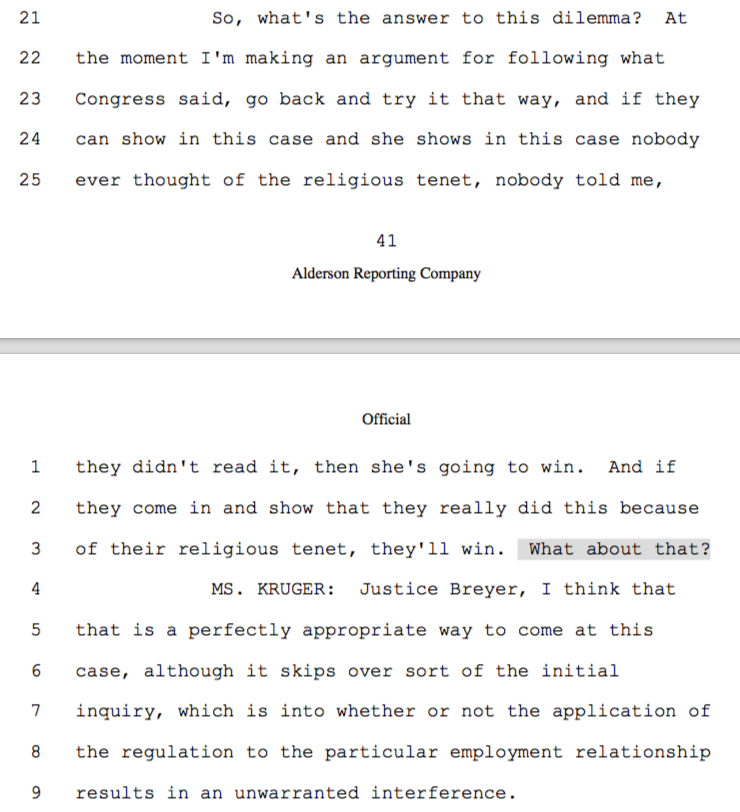One of the best part of writing constitutional law exams is that I can spin counterfactuals, asking what if? In this question, Obergefell came out the other way, with the Court finding that the Constitution does not guarantee a right to same-sex marriage. Afterwards, Davis Kim, the clerk of Jefferson County, Kentucky, decides that Obergefell is not legitimate, like Dred Scott, and that Kentucky’s law limiting marriage to one man and one woman is unconstitutional. He distributes marriage licenses in contravention to state law. This tees up the issues of judicial supremacy and departmentalism in a way that forces the students to (perhaps) criticize Davis, who is taking a policy position they (likely) agree with. In addition, a student at the University of Louisville is denied entry to a “safe space” reserved for LGBT students, and is expelled for engaging in “hate speech” (reading a sentence from Justice Scalia’s Romer dissent). Enjoy the question!
Instructions: You are a law clerk for the Chief Justice of the Supreme Court of Kentucky. In the wake of the Supreme Court’s surprise decision in Obergefell finding that there was no right to same-sex marriage, the situation has quickly unraveled in Kentucky. Several cases have been appealed to the Supreme Court of Kentucky. In a memorandum of no more than 1,000 words, please address five questions concerning these consolidated cases.
—
It is June 26, 2015. In a stunning surprise, the Supreme Court affirmed the Sixth Circuit’s decision in Obergefell v. Hodges. Writing for a divided 5-4 Court, Justice Kennedy held that while the 14th Amendment’s Due Process Clause protects private intimate conduct, see Lawrence v. Texas, it does not extend to providing a positive government benefit such as a marriage license. Further, classifications based on sexual orientation were only quasi-suspect under the 14th Amendment’s equal protection clause, and the state had an important interest in encouraging opposite-sex couples who procreate to stay together for the benefit of their children. Such laws were not passed out of animus for gays and lesbians, but as a means to preserve this millennia-old social institution. As a result, Kentucky’s law limiting marriage to one man and one woman remains constitutional, and on the books.
In her vigorous dissent, Justice Ginsburg charged that the decision will be remembered alongside Dred Scott as one of the greatest injustices from the Supreme Court. She anticipated that the people would not accept this ruling. As usual, RBG’s notorious prediction quickly proved to be accurate.
Shortly after the decision was published, Davis Kim, the county clerk of Jefferson County, Kentucky announced that he would begin to issue marriage licenses to same-sex couples. In a detailed letter, Kim explained that the Supreme Court’s decision in Obergefell was illegitimate—citing Justice Ginsburg’s reference to Dred Scott—and an incorrect interpretation of the Fourteenth Amendment. Kim noted that based on his study of the Constitution, the Fourteenth Amendment guarantees same-sex couples the “dignity” of marriage equality. Kim stated bluntly, “The Supreme Court does not have a monopoly on interpreting the Constitution.” As a result, Kim disregarded Kentucky’s law limiting marriage to opposite-sex couples, and issued a marriage license to James and Arthur.
The Governor of Kentucky was furious with Kim and ordered him to stop issuing marriage licenses to same-sex couples. The Governor tells Kim to “Follow the law or resign.” Kim replies that he is following the law as he understands it—the U.S. Constitution—and as an elected official, he will not resign. He serves the people of Jefferson County, who support him. The Governor files suit in state court, seeking an injunction to halt the issuance of same-sex marriage licenses, and to force Kim to comply with the Kentucky law limiting marriage to opposite-sex couples. The trial court issues the injunction. Kim promptly appeals the case directly to the Supreme Court of Kentucky.
The Jefferson County Council supports Kim, and enacts the Jefferson Equal Rights Ordinance (JERO). The law prohibits discrimination against people on the basis of their sexual orientation or gender identity. James and Arthur apply as a married couple for public housing in Jefferson County. Even though their marriage license is void under Kentucky law, adhering to JERO, the County approves the application, and grants them a benefit reserved for married couples.
The people of Kentucky were very distraught by Kim’s actions, as well as JERO. Citizens collected enough signatures to place on the ballot a repeal of JERO. A massive advertising blitz begins urging people to vote “No,” and repeal JERO. Some commercials charged that JERO would allow men to enter women’s bathrooms. Other commercials charged that JERO and Kim’s decisions are contrary to valid state law, which clearly prohibits the recognition of any same-sex marriages. By a vote of 61%-39%, JERO is repealed. As a result, James and Arthur—no longer considered married—are evicted from their public housing. The couple files suit in state court, charging that the repeal of JERO violates the Fourteenth Amendment. (They do not bring any other claims under state or federal law). The trial court rules against the couple, finding that with JERO repealed, the eviction was required under Kentucky law. James and Arthur promptly appeal to the Supreme Court of Kentucky.
The repeal of JERO is felt strongly at the University of Louisville, a public university in Jefferson County. Members of the LGBT community on campus felt threatened by recent events. They request from the administration a “safe space” on campus where only lesbian, gay, bisexual, and transgender students can congregate—all others would be excluded. In this space, the students can talk amongst themselves to heal and discuss issues of concern to the LGBT community, without worrying that outsiders may marginalize their message. The President of the University grants their request, and designates a room in the Student Union as a “safe space.” He orders the Dean to stand outside the room, and exclude anyone who does not meet the criteria for admission.
Nino, a student who does not identify as LGBT, attempts to enter the “safe space.” The Dean refuses his entry. Nino exclaims that his request to enter was a “modest attempt to preserve traditional sexual mores against the efforts of a politically powerful minority to revise those mores.” Students who overhear Nino become very upset and offended. Irate, the Dean immediately expels Nino from the University for engaging in “hate speech.”
Nino files suit in state court with two claims. First, he argues that his exclusion from a place of public accommodation at the public university violates the Fourteenth Amendment’s equal protection clause. Second, Nino argues that his expulsion from the public university for “hate speech” violates his right to free speech under the First Amendment. (Nino does not bring any claims under state or federal law).
The trial court rules in Nino’s favor for the first count, finding that excluding him from the “safe space” was an unconstitutional classification in violation of the Fourteenth Amendment. However, for the latter count, the court upholds the suspension, finding that Nino’s outburst caused a substantial disruption in the student union. Nino and the University of Louisville promptly cross-appeal to the Supreme Court of Kentucky.
—
The Supreme Court of Kentucky has consolidated each of the appeals into a single case. In a memorandum of no more than 1,000 words, address the following five questions for the Chief Justice. Please keep in mind the Supreme Court’s recent decision in Obergefell, finding that bans on same-sex marriage violate neither the Due Process Clause nor the Equal Protection Clause of the 14th Amendment.
- Address whether the repeal of JERO by the voters violated the 14th Amendment.
- Address whether the University’s exclusion of Nino from the “safe space” violated the 14th Amendment’s guarantee of equal protection.
- Address whether the University’s expulsion of Nino for his “hate speech” violated the 1st Amendment’s guarantee of freedom of speech.
- The Chief Justice (your boss) was deeply disappointed by the Supreme Court’s decision in Obergefell, and deeply believes that the 14th Amendment guarantees a right to same-sex marriage. Further, the Chief admires Abraham Lincoln, a native son of Kentucky, and his views towards the Supreme Court’s finality about the Constitution. Offer the strongest arguments in favor of Kim’s position that he is not bound by the Supreme Court’s decision in Obergefell.
- The Chief Justices poses an additional question to you, separate and apart from the previous question of why Davis is not bound by the Supreme Court’s ruling. He asks you, “Why do people obey courts?” Address that question, and keep in mind the separation of powers and the rule of law.

